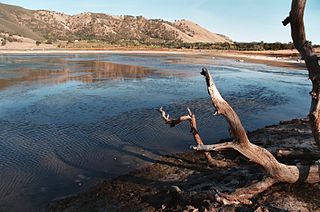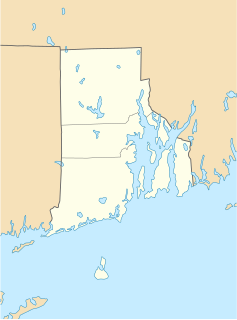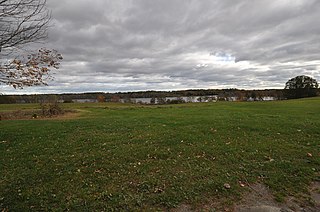Related Research Articles

The Borax Lake Site, also known as the Borax Lake—Hodges Archaeological Site and designated by the Smithsonian trinomial CA-LAK-36, is a prehistoric archaeological site near Clearlake, California. The site, a deeply stratified former lakeshore, contains evidence of the earliest known period of human habitation in what is now California, dating back 12,000 years. A portion of the site, designated a National Historic Landmark in 2006, is owned and preserved by the Archaeological Conservancy.

The Horner Site, also known as the Creek Site and Horner's Corner Site, and designated by the Smithsonian trinomial 48PA29, is an important archaeological site near Cody, Wyoming. It is the type site for the Cody complex. It was declared a National Historic Landmark in 1961.
Pine Hill Archeological Site, RI-655 is a prehistoric archaeological site on Prudence Island in Portsmouth, Rhode Island. The site's principal feature is a coastal shell midden dating to the Late Woodland period. Finds at the site include projectile points, stone tools, bones, and ceramics.

The Greenwich Cove Site is a prehistoric archaeological site in Warwick, Rhode Island. The site is a significant multi-component site, with finds dating from the Late Archaic to the Middle Woodland Period. It notably includes a shell midden that has only been moderately affected by vandalism and development; these are particularly rare in coastal Rhode Island. The site was added to the National Register of Historic Places in 1980.

The Wampanucket Site is a pre-historic archaeological site in Middleborough, Massachusetts, United States. Located near Assawompset Pond, it is a major Paleo-Indian site providing evidence of human habitation as far back as 12,000 years ago. Finds at the site include projectile points from both the Early Archaic and Late Woodland Periods. Evidence of human habitation extends across a number of prehistoric periods and into the colonial period, when the area was occupied by a subgroup of the Wampanoag tribe.
Brinsfield I Site, or Brinsfield I Prehistoric Village Site, is an archaeological site near Cambridge in Dorchester County, Maryland. The site was first identified in 1955 by Perry S. Flegel of the Sussex Society of Archaeology & History. It is a late prehistoric archaeological site characterized by shell-tempered pottery and triangular projectile points. The site may provide evidence of prehistoric life on the eastern shore of Maryland during the Late Woodland period, c. 900–1500.

The Book Site is an archaeological site in Juniata County, Pennsylvania, United States. Consisting of the remnants of a burial mound and a prehistoric village, the site lies on both sides of Camp Resort Road in Beale Township, near the community of Beale.

The LoDaisKa Site is a prominent archaeological site in the U.S. state of Colorado, located within a rockshelter near Morrison. The rockshelter was first inhabited by people of the Archaic through the Middle Ceramic period, generally spanning 3000 BC to 1000 AD.

Hirundo Wildlife Refuge is a wildlife refuge covering 2,402 acres (972 ha) along Pushaw and Dead streams in Penobscot County, Maine. The refuge was founded in 1965 by Oliver Larouche from his parent's 3 acres (1.2 ha) camp. The refuge was donated as a trust to the University of Maine in 1983 by Larouche and his wife, June. The refuge is a living laboratory where current and past scientific research has been conducted. Hirundo is just downstream of Pushaw Lake and includes part of the Caribou Bog wetland complex, which is one of the largest wetlands in Maine. The refuge is also the site of the National Register-listed Hirundo Site, a prehistoric Native American habitation site with evidence of 4,500 years of occupation.

The Coombe Historic District is a national historic district located at Felton, Kent County, Delaware. It encompasses two contributing buildings and one contributing structure near the town of Felton representing an unusual mixture of archaeological resources, both prehistoric and historic, in combination with two excellent examples of domestic architecture from the 18th and 19th centuries. They are the brick Benjamin Coombe House, built in 1778, and the frame Caldwell House, built about 1872, with their respective outbuildings. It also includes the Hopkins Cemetery, begun in the late-19th century, and three historic archaeological house sites, as well as an area of prehistoric occupation that was listed in the National Register of Historic Places in 1979 as "Area F" in the Hughes Early Man Complex.
The Carey Farm Site (7K-D-3) is a prehistoric Native American archaeological site in central Kent County, Delaware, near Dover. The site, located along the St. Jones River, encompasses what is believed to be a major seasonal base camp from the Woodland Period. Ceramics dating to 200 CE have been found at the site.
The Paw Paw Cove Site is an archaeological site on the coast of Talbot County, Maryland. The site, first identified in 1979, is a complex of three locations on 500 metres (1,600 ft) of shoreline on Chesapeake Bay, at which stone artifacts with an estimated date of 11,500 to 10,500 BCE have been found. Among the finds are fluted projectile points and flakes created during the manufacture of such points.
The Hughes-Willis Site is a prehistoric Native American archaeological site in Kent County, Delaware. It is located in Dover, Delaware on the banks of the Little River, and was identified in 1971. The site contains evidence of occupation dating back 5,000 years, with its most significant occupational period being the Middle Woodland Period. Finds at the site include projectile points, and tools for cutting and scraping made of stone. The evidence suggests the site was occupied seasonally, probably sometime in the period between late fall and mid-winter.
The Island Field Site (7K-F-17) is a major archaeological site in Kent County, Delaware, United States. The site is located in South Bowers, just south of the Murderkill River near where it empties into Delaware Bay. The site was a major prehistoric Native American village site, which was most notable for its cemetery. The site was first identified in the 1920s during road work, and was excavated in the 1950s-60s, after which the area was eventually built up to include a museum. In 1986 members of the local Nanticoke tribe protested the display and removal for research of burial remains at the site.
7K-F-4 and 7K-F-23 are a pair of archaeological sites in southern Kent County, Delaware, near the town of Milford. Both are Early Woodland Period Native American camp sites, at which ceramics have been found.
The Dill Farm Site (7K-E-12) is a prehistoric archaeological site in Kent County, Delaware, near the town of Sandtown. The site located in a formerly swampy area, has yielded dates of 500 BC and 8000 BC. Carey Complex ceramics have also been found at the 55-acre (22 ha) site.
The Indian River Archeological Complex is a collection of archaeological sites near Millsboro, Delaware, encompassing what is the only known riverine settlement in Sussex County during the Middle Woodland Period. It consists of three separate sites, 7S-F-11, 7S-F-12, and 7S-F-13. These sites appear to have been semi-permanent seasonal settlements, occupied during the spring and fall, and abandoned for other hunting and fishing grounds in the summer and winter. Finds at each site include both worked stone artifacts including projectile points, as well as different types of ceramics. The combination of finds raises questions about the pattern of cultural migration in the area, which further investigation of the sites may shed light on. Of the three sites, two have been subjected to surface-level collection, and one, 7S-F-13, has been subjected to more intensive excavations.
The Thayer Farm Site, designated by the Smithsonian trinomial 31RD10, is a prehistoric archaeological site in Randolph County, North Carolina. The site, long known to local collectors for surface level finds, was formally investigated in 1984, and was found to consist of a stratified series of deposits bearing evidence of occupation between about 1200 and 1700 AD. Finds at the site include pottery fragments, projectile points, animal bone, shell fragments, and human bone, the latter indicating the presence of burials. Two acres of the site were donated to the Historic Preservation Foundation for North Carolina in 1985.

The Hunter Site, designated 15.110 by the Maine Historic Preservation Commission and also known as the Hunter Farm Site, is a prehistoric archaeological site on the banks of the Androscoggin River in Topsham, Maine. The site, located on the Hunter family farm in eastern Topsham, is a Late Archaic Native American habitation site, dating to 4000–5000 years before present. Finds at the site include calcined fragments of fish bones, indicative that the inhabitants' diet included striped bass and sturgeon. Stone tools, including projectile points, have also been found at the site.
The Sebre Lake Site is a prehistoric Native American archaeological site in Fort Ripley Township, Minnesota, United States. It has yielded habitation and burial features accumulated over 4,000 years of intermittent use from the mid-Archaic to the early Late Woodland period. The site was listed on the National Register of Historic Places in 1984 for having local significance in the theme of archaeology. It was nominated for being one of the richest archaeological sites in the Nokasippi River Valley.
References
- 1 2 "National Register Information System". National Register of Historic Places . National Park Service. July 9, 2010.
- ↑ Custer, Jay (1984). Delaware Prehistoric Archaeology. University of Delaware Press. pp. 37, 58, 188. ISBN 9780874132335.